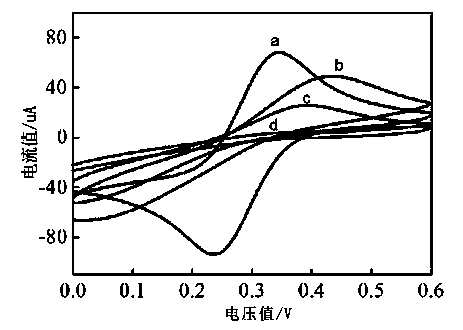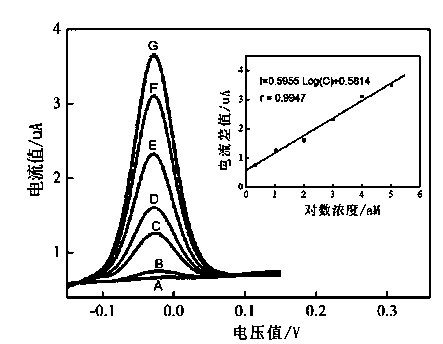Preparation method and application of hybridization indicator 5,7-binitro-2-sulfo-acridone
A technology of acridone and dinitro, which is applied in the field of preparation of hybridization indicator 5,7-dinitro-2-sulfo-acridone, which can solve the problems of low sensitivity, high price and lack of economy , to achieve the effect of strong selectivity, high specificity detection and high electrochemical activity
- Summary
- Abstract
- Description
- Claims
- Application Information
AI Technical Summary
Problems solved by technology
Method used
Image
Examples
Embodiment 1
[0032] The characterization data of DSA are as follows:
[0033] Elemental analysis of DSA: C, 42.83 %; H, 1.99 %; N, 11.52 %. (Calculated value: C, 42.75 %; H, 1.93 %; N,11.50 %); Infrared analysis of DSA IR (KBr)ν: 3410(υNH), 1592(υC-C), 1642(υC =C), 1389 (υC-NO2), 1190 (υSO2OH).
[0034] Mass spectrometry of DSA FAB-MS: m / z 366 ([M+1]+).
[0035] DSA hydrogen spectrum analysis 1H NMR (CDCl3, δ): 9.04 (s, ArH), 8.76 (s, ArH), 8.13 (s, ArH), 7.85 (d, ArH), 6.87 (d, ArH), 4.21 ( s, NH).
Embodiment 2
[0037] The electrochemical sensor of the present invention comprises a glassy carbon electrode GCE, the surface is coated with a sensitive film, ExoIII enzyme, and auxiliary sequences AP1 and AP2. The sensitive membrane is composed of polylysine PLLy and immobilized hairpin probe gene P (5'-NH2-AAA AAT TTA TTT GAT AGG CGA ACT ATT TGT TTT TAA TAT CAA ATA ATG GTT-3'), which will immobilize the probe The glassy carbon electrode of DNA is immersed in PBS (phosphate pH 7.0) buffer solution containing a certain concentration of complementary DNA (T1) for hybridization reaction. Put the hybridized electrode in 10 U ExoIII enzyme buffer, and eliminate it by shearing at 37 °C, because ExoIII can gradually degrade the probe gene P from the blunt end of the 3′ end until the part that hybridizes with T1 to form a double strand is completely degraded , leaving some genes not hybridized with T1 remaining on the surface of the electrode. At the same time, T1 is released intact and can conti...
Embodiment 3
[0047] The above electrochemical sensor is used to detect c-erbB-2 related genes. The specific detection method is as follows: the glassy carbon electrode immobilized with the hairpin probe DNA is immersed in a solution containing a certain concentration of complementary DNA for hybridization reaction. The hybridized electrode was placed in 10 U of exonuclease III buffer, and cut and eliminated at 37 °C, the probe P transformed from a hairpin structure to a flexible short linear structure. Auxiliary probes AP1 and AP2 solutions were added dropwise on the electrode surface, and DNA long-distance self-assembly was carried out at room temperature. The long-distance self-assembled electrode was placed in a pH 7.0 PBS buffer solution containing 5,7-dinitro-2-sulfo-acridone to allow it to be embedded in the double helix structure of DNA. After the above-mentioned electrodes are washed and dried, they can be placed in PB buffer solution and detected by square wave voltammetry.
[00...
PUM
 Login to View More
Login to View More Abstract
Description
Claims
Application Information
 Login to View More
Login to View More - R&D
- Intellectual Property
- Life Sciences
- Materials
- Tech Scout
- Unparalleled Data Quality
- Higher Quality Content
- 60% Fewer Hallucinations
Browse by: Latest US Patents, China's latest patents, Technical Efficacy Thesaurus, Application Domain, Technology Topic, Popular Technical Reports.
© 2025 PatSnap. All rights reserved.Legal|Privacy policy|Modern Slavery Act Transparency Statement|Sitemap|About US| Contact US: help@patsnap.com



